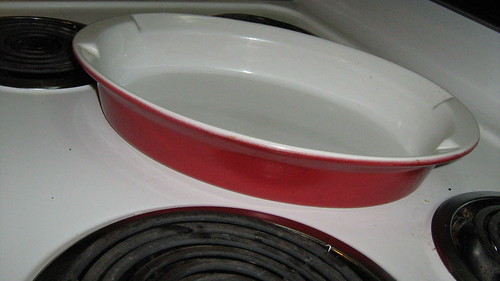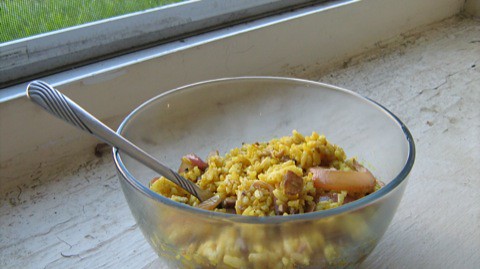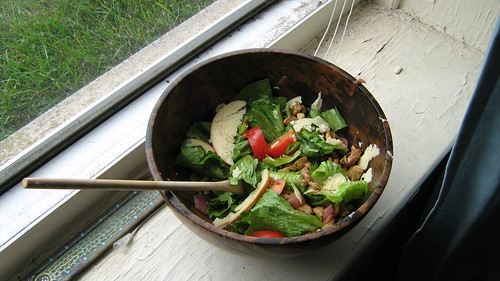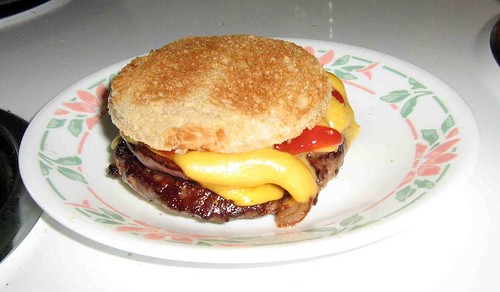
Decadence in food is simultaneously misunderstood and underrated.
The prevailing opinion on decadence seems to be that it either requires exotic ingredients or intensive preparation. Quail eggs poached in the tears of a war widow might make somebody's bow tie spin, but in my head it would be much, much easier to provoke a similar reaction from a hungry patron with peanut butter on fresh, seeded rye: just use the heels of the loaf, under-toast them, sprinkle the surface with kosher salt and serve open-faced.
For my father and I for coming up on fifteen years now, the epitome of decadence is shrimp salad on white toast with lettuce, particularly if it comes from the
3 Guys Restaurant across from the
Whitney Museum on Madison Avenue in New York City.
Making good shrimp salad isn't difficult, but the ubiquity and low cost of canned tuna has made it far rarer than it really should be. Part of that is because of the perception of shrimp as exotic, crowding the rims of chilled martini glasses filled with ice and cocktail sauce in restaurants with six dollar glasses of water. That perception is deserved to an extent - shrimp for shrimp cocktail, usually branded as "Colossal" by fishmongers, look to be the size of hockey pucks; I say
look because I've never actually been able to justify to myself the cost of buying them.
The thing about shrimp salad, though, is that you're going to be cutting the shrimp up and spending money on the big ones is a serious waste of money: frozen 41-50 count shrimp are 4 or 5 dollars a pound in my neighborhood depending on if they're on sale or not, which is actually
cheaper than name-brand tuna in a can by weight, even after factoring in the mostly negligible weight of shells and tails.
You
can simply substitute cut up shrimp into your grandma's tuna salad recipe if you'd like (though I would cut down on the mayo content a bit to let the shrimp take a bit more control of the thing) but if you'd like something designed for shrimp, try this:

It's hard to be specific about quantities here - a lot depends on the water content of your shrimp, your particular brand of mayo, etc. I'm going to try and give you rules of thumb to keep things easy.
Ingredients:
- Shrimp, frozen or thawed, in their shells
- Lemon juice
- Mayonnaise
- Tomato, prepared as below
- Scallions (optional)
- Parsley, fresh ideally, dried in a pinch
- Paprika
- salt and pepper
Theory:
If this were tuna salad, you'd want to add something to fight your teeth a little, an element of crunch. Onion can fill this role, though celery is more common. This is shrimp, though, and the shrimp is going to fight all on its own with a little help from the tomato. You want the sharp bite of the onion, though, which is where the scallions come in. You can go without if you really want to; experiment.
The Gist:
Boil some water and add the shrimp, still in their shells, to the pot - shrimp shells have a ton of flavor and you want that flavor to stay with the shrimp instead of letting it bleed out into the water. Keep an eye on them. You're going to want to boil them for only a few minutes until just before they're done; they'll finish cooking on their own. Cook them too long and they'll lose all of their moisture.
Strain the shrimp into a colander under hot water for a minute, then warm, then cold - you want to step them down from boiling to cool enough to handle.
Shell them. Most commercially available unshelled shrimp these days come with their shells cracked for you and the boiling probably separated the shells slightly from the meat, making it easier. Chop the shrimp into halves or thirds, no smaller. put them into a bowl.
Add enough mayonnaise to the bowl to lightly coat the shrimp. You won't need much, a heaping teaspoon or so. Add approximately half as much chopped tomato meat as you had shrimp. Tomatoes are mostly water - you want to add the drier outside part of the tomato, not the wetter, seedy part. Add half as much chopped scallions as you added tomato, and a healthy pinch of parsley, salt and pepper. Squeeze half a lemon over it, tasting as you go to make sure you don't overdo it. The Paprika is mostly for color.
Refrigerate for 15-30 minutes before eating - you'll want the flavors to commingle and enhance each other, and it tastes better cold.
Serve on white toast with lettuce. It's good on wheat, too, but wheat tries to steal the spotlight; white stays mostly neutral.
Considerations:
- Once you get the hang of it, you can start substituting this for that. One of my favorite variations is to replace the mayonnaise with whatever salad dressing I have in the fridge at the time. It's particularly good with bleu cheese.
 I'm pretty good with tech, but cameras and I have never really gotten along.
I'm pretty good with tech, but cameras and I have never really gotten along. ...going forward.
...going forward.













